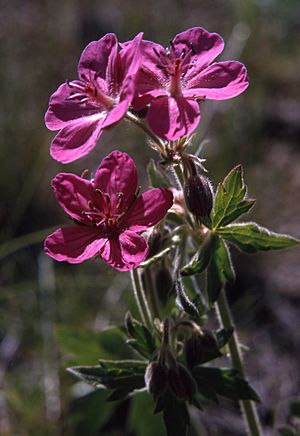Sticky purple geranium facts for kids
Quick facts for kids Sticky purple geranium |
|
|---|---|
 |
|
| Scientific classification | |
| Genus: |
Geranium
|
| Species: |
viscosissimum
|
| Synonyms | |
|
Geranium attenuilobum G.N. & F.F. Jones |
|
The Geranium viscosissimum, also known as the sticky purple geranium, is a beautiful plant. It is a perennial flowering plant, which means it lives for more than two years. This plant belongs to the Geraniaceae family. Scientists think it might be a protocarnivorous plant, which is a plant that seems to catch insects but might not get nutrients from them like true carnivorous plants do.
Contents
Where It Grows
This sticky purple geranium is a perennial plant found in many places. It grows naturally in the Northwestern United States, California, and Nevada. You can also find it in the Great Basin and Rocky Mountains. Further north, it grows in Western Canada, including the Canadian Rockies.
You can spot this plant in different natural areas. It likes yellow pine forests and northern juniper woodlands. It also grows in meadows, from lowlands to higher up in the mountains. You can find it near water, in wetlands and along rivers. It grows at elevations from about 1,000 to 2,500 meters (3,300 to 8,200 feet) high.
What It Looks Like
The Geranium viscosissimum is a large wild geranium. It grows in clumps and can reach about 0.5 to 3 feet (0.15 to 0.9 meters) tall. Its stem, leaves, and flower stalks are covered with sticky hairs. This is where it gets its "sticky" name! The leaves are bright green, deeply cut, and have many teeth along their edges.
This plant blooms from April to September. The exact time depends on how high up it grows and how far north it is. Its flowers are about 1.5 inches (3.8 cm) wide and shaped like saucers. They are pink with reddish-purple lines on the petals. These pretty flowers grow in an open bunch near the top of strong, branching stalks. These stalks can be 1 to 2 feet (0.3 to 0.6 meters) tall.
Is It a Meat-Eating Plant?
In 1999, a scientist named G.G. Spomer studied plants in the Pacific Northwest. He wanted to see if any of them were carnivorous. He checked if they could break down proteins, which is what meat-eating plants do to get food from insects.
The sticky purple geranium showed it could break down and take in a special protein. This protein was placed on the plant's sticky hairs. However, scientists are not sure if the plant itself makes the chemicals to break down the protein. Tiny living things on the plant's surface might be doing it instead. Also, for a plant to be truly carnivorous, it needs to get a real benefit from eating insects. For example, it might grow bigger or make more seeds. This kind of study has not been done yet for the sticky purple geranium. So, while it's sticky and can break down protein, it's not fully proven to be a "meat-eating" plant.
How People Use It
The flowers and leaves of the sticky purple geranium can be eaten. However, they are said to be "astringent," which means they might make your mouth feel a bit dry or puckery. You can add the flowers to salads or use them to decorate food.
Traditional Medicine
The Blackfeet Indians, a Native American tribe, used this plant for medicine. They made a special drink from it to help with diarrhea and upset stomachs. They also used it for problems with their urinary system. The root of this plant is also astringent. Native Americans would dry the root and grind it into a powder. They used this powder to help stop bleeding from cuts or wounds.
Growing It in Gardens
The Geranium viscosissimum is grown by special plant nurseries. People buy it to plant in their gardens because it is pretty. It is often used in native plant gardens and wildlife gardens. This plant is great because it helps attract butterflies!
Images for kids


